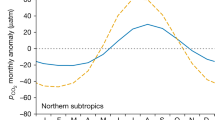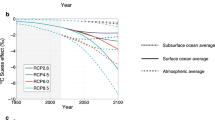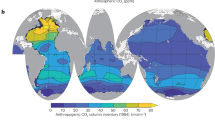Abstract
Present estimates of the future oceanic uptake of anthropogenic CO2 and calculations of CO2-emission scenarios1 are based on the assumption that the natural carbon cycle is in steady state. But it iswell known from palaeoclimate records2,3,4,5 and modelling studies6,7,8,9 that the climate system has more than one equilibrium state, and that perturbations can trigger transitions between them. Anticipated future changes in today's climate system due to human activities have the potential to weaken the thermohaline circulation of the North Atlantic Ocean10,11,12, which would greatly modify estimates of future oceanic CO2 uptake13. Here we use a simple coupled atmosphere–ocean climate model to show that the Atlantic thermohaline circulation is not only sensitive to the final atmospheric CO2 concentration attained, but also depends on the rate of change of the CO2 concentration in the atmosphere. A modelled increase to 750 parts per million by volume (p.p.m.v.) CO2 within 100 years (corresponding approximately to a continuation of today's growth rate) leads to a permanent shut-down of the thermohaline circulation. If the final atmospheric concentration of 750 p.p.m.v. CO2 is attained more slowly, the thermohaline circulation simply slows down. The reason for this rate-sensitive response of the climate system lies with the transfer of buoyancy in the form of heat and fresh water from the uppermost layers of the ocean into the deep waters below. This sensitivity of the simulated thermohaline circulation to the rate ofchange of atmospheric CO2 concentration has potentially important implications for the choice of future CO2-emission scenarios1.
This is a preview of subscription content, access via your institution
Access options
Subscribe to this journal
Receive 51 print issues and online access
$199.00 per year
only $3.90 per issue
Buy this article
- Purchase on Springer Link
- Instant access to full article PDF
Prices may be subject to local taxes which are calculated during checkout




Similar content being viewed by others
References
Houghton, J. T.et al. (eds) Climate Change 1995: The Science of Climate Change(Cambridge Univ. Press, (1996)).
Oeschger, H.et al. in Climate Processes and Climate Sensitivity(eds Hansen, J. E. & Takahashi, T.) 299–306 (Geophys. Monogr. 29, Am. Geophys. Un., Washington DC, (1984)).
Broecker, W. S., Peteet, D. & Rind, D. Does the ocean–atmosphere system have more than one stable mode of operation? Nature 315, 21–25 (1985).
Broecker, W. S. & Denton, G. H. The role of ocean-atmosphere reorganizations in glacial cycles. Geochim. Cosmochim. Acta 53, 2465–2501 (1989).
Bond, G.et al. Correlations between climate records from North Atlantic sediments and Greenland ice. Nature 365, 143–147 (1993).
Bryan, F. High-latitude salinity effects and interhemispheric thermohaline circulations. Nature 323, 301–304 (1986).
Manabe, S. & Stouffer, R. J. Two stable equilibria of a coupled ocean-atmosphere model. J. Clim. 1, 841–866 (1988).
Maier-Reimer, E. & Mikolajewicz, U. Experiments with an OGCM on the cause of the Younger Dryas 1–13 (Tech. Rep. 39, Max-Planck-Inst. für Meteorol., Hamburg, (1989)).
Stocker, T. F. & Wright, D. G. Rapid transitions of the ocean's deep circulation induced by changes in surface water fluxes. Nature 351, 729–732 (1991).
Manabe, S., Stouffer, R. J., Spelman, M. J. & Bryan, K. Transient responses of a coupled ocean-atmosphere model to gradual changes of atmospheric CO2. Part I: Annual mean response. J. Clim. 4, 785–818 (1991).
Manabe, S. & Stouffer, R. J. Century-scale effects of increased atmospheric CO2on the ocean–atmosphere system. Nature 364, 215–218 (1993).
Manabe, S. & Stouffer, R. J. Multiple-century response of a coupled ocean-atmosphere model to an increase of atmospheric carbon dioxide. J. Clim. 7, 5–23 (1994).
Sarmiento, J. L. & Le Queré, C. Oceanic carbon dioxide in a model of century-scale global warming. Science 274, 1346–1350 (1996).
Neftel, A., Oeschger, H., Staffelbach, T. & Stauffer, B. CO2record in the Byrd ice core 50,000–5,000 years BP. Nature 331, 609–611 (1988).
Broecker, W. S. Unpleasant surprises in the greenhouse? Nature 328, 123–126 (1987).
Maier-Reimer, E., Mikolajewicz, U. & Winguth, A. Future ocean uptake of CO2: interaction between ocean circulation and biology. Clim. Dyn. 12, 711–721 (1996).
Wright, D. G. & Stocker, T. F. Sensitivities of a zonally averaged global ocean circulation model. J. Geophys. Res. 97, 12707–12730 (1992).
Stocker, T. F., Wright, D. G. & Mysak, L. A. Azonally averaged, coupled ocean-atmosphere model for paleoclimate studies. J. Clim. 5, 773–797 (1992).
Wright, D. G., Vreugdenhil, C. B. & Hughes, T. M. Vorticity dynamics and zonally averaged ocean circulation models. J. Phys. Oceanogr. 25, 2141–2154 (1995).
Chen, D., Gerdes, R. & Lohmann, G. A1-D atmospheric energy balance model developed for ocean modelling. Theor. Appl. Climatol. 51, 25–38 (1995).
Weaver, A. J., Marotzke, J., Cummins, P. F. & Sarachik, E. S. Stability and variability of the thermohaline circulation. J. Phys. Oceanogr. 23, 39–60 (1993).
Schiller, A., Mikolajewicz, U. & Voss, R. The stability of the thermohaline circulation in a coupled ocean-atmosphere general circulation model. Clim. Dyn. 13, 325–347 (1997).
Egger, J. Flux correction: tests with a simple ocean-atmosphere model. Clim. Dyn. 13, 285–292 (1997).
Shine, K. P., Derwent, R. G., Wuebbles, D. J. & Morcrette, J. -J. in Climate Change: The IPCC Scientific Assessment(eds Houghton, J. Y., Jenkins, G. J. &Ephraums, J. J.) 41–68 (Cambridge Univ. Press, (1990)).
Johns, T. C.et al. The second Hadley Centre coupled ocean-atmosphere GCM: model description, spinup and validation. Clim. Dyn. 13, 103–134 (1997).
Mikolajewicz, U. & Maier-Reimer, E. Mixed boundary conditions in ocean general circulation models and their influence on the stability of the model's conveyor belt. J. Geophys. Res. 99, 22633–22644 (1994).
Rahmstorf, S. Bifurcations of the Atlantic thermohaline circulation in response to changes in the hydrological cycle. Nature 378, 145–149 (1995).
Rahmstorf, S., Marotzke, J. & Willebrand, J. in The Warmwatersphere of the North Atlantic Ocean(ed. Krauss, W.) 129–157 (Bornträger, Berlin, (1996)).
Wigley, T. M. L., Richels, R. & Edmonds, J. A. Economic and environmental choices in the stabilization of atmospheric CO2concentrations. Nature 379, 240–243 (1996).
Acknowledgements
We thank N. Gruber, F. Joos, O. Marchal, H. Oeschger, S. Rahmstorf, A. Weaver and D. Wright for comments. This work was supported by the Swiss National Science Foundation.
Author information
Authors and Affiliations
Corresponding author
Rights and permissions
About this article
Cite this article
Stocker, T., Schmittner, A. Influence of CO2 emission rates on the stability of the thermohaline circulation. Nature 388, 862–865 (1997). https://doi.org/10.1038/42224
Received:
Accepted:
Issue Date:
DOI: https://doi.org/10.1038/42224
This article is cited by
-
Multi-proxy constraints on Atlantic circulation dynamics since the last ice age
Nature Geoscience (2023)
-
Delayed recovery of the tropical rain belt
Nature Climate Change (2022)
-
Impacts of climate change on tropical cyclones and induced storm surges in the Pearl River Delta region using pseudo-global-warming method
Scientific Reports (2020)
-
Enhanced Incorporation of Gaseous CO2 to Succinate by a Recombinant Escherichia coli W3110
Biotechnology and Bioprocess Engineering (2019)
-
Observable, low-order dynamical controls on thresholds of the Atlantic meridional overturning circulation
Climate Dynamics (2019)
Comments
By submitting a comment you agree to abide by our Terms and Community Guidelines. If you find something abusive or that does not comply with our terms or guidelines please flag it as inappropriate.



